The number of Ukrainian Covid-19 cases is now ‘nobody gives a f***.’ Quite right. True existential threats put things in perspective. If you are more worried about catching Covid-19 than you are about the war and its possible escalation, you have a poor threat model.
That does not mean that we can stop paying attention to Covid-19. Prevention efforts continue to hamper our way of life, our social fabric and our lived experience.
The good news is that this is rapidly ramping down in many places, and perhaps coming to an end. The CDC has revised its mask guidelines to target a much more sensible metric, and now recommends unmasking in a large portion of the country. I would go farther, but the offer seems acceptable, and at worst fully in line with their stands against such joys as munching on raw cookie dough. New York where I live is lifting both its mask and vaccine mandates soon, including in schools. Many other states are doing the same.
The other good news is that my wife and I will welcome our third child later today. I managed to finish almost everything for this post yesterday, although I won’t be able to do a proper dive on Biden’s new 96-page plan. I hope to be able to continue updates without interruption, but it is possible next week’s will be an exception or stick to only the bare essentials.
Let’s run the numbers.
Executive Summary
- CDC revises masking guidelines to be based on hospital capacity.
- Mask and vaccine mandates are being lifted in many places.
- Attention rightfully shifts to the Russian invasion of Ukraine.
Let’s run the numbers.
The Numbers
Predictions
Prediction from last week: 340k cases (-30%) and 10,460 deaths (-20%).
Results: 329k cases (-33%) and 11,333 deaths (-13%).
Prediction for next week: 247k cases (-25%) and 9.200 deaths (-19%).
I keep expecting deaths to drop more than they do, and each week they keep dropping much less than cases drop. That seems like it can’t be sustained, and it feels like we are learning a lot about the time distribution of deaths, but at some point it’s going to have to come down. Nothing changed in terms of the actual death rate, so it doesn’t make any sense. Still, I have to expect something similar to continue for now.
Cases continue to drop at a steady pace. Restrictions are being weakened in many places, so I’d expect the drop to slow down, but I don’t expect it to stall or reverse.
Deaths
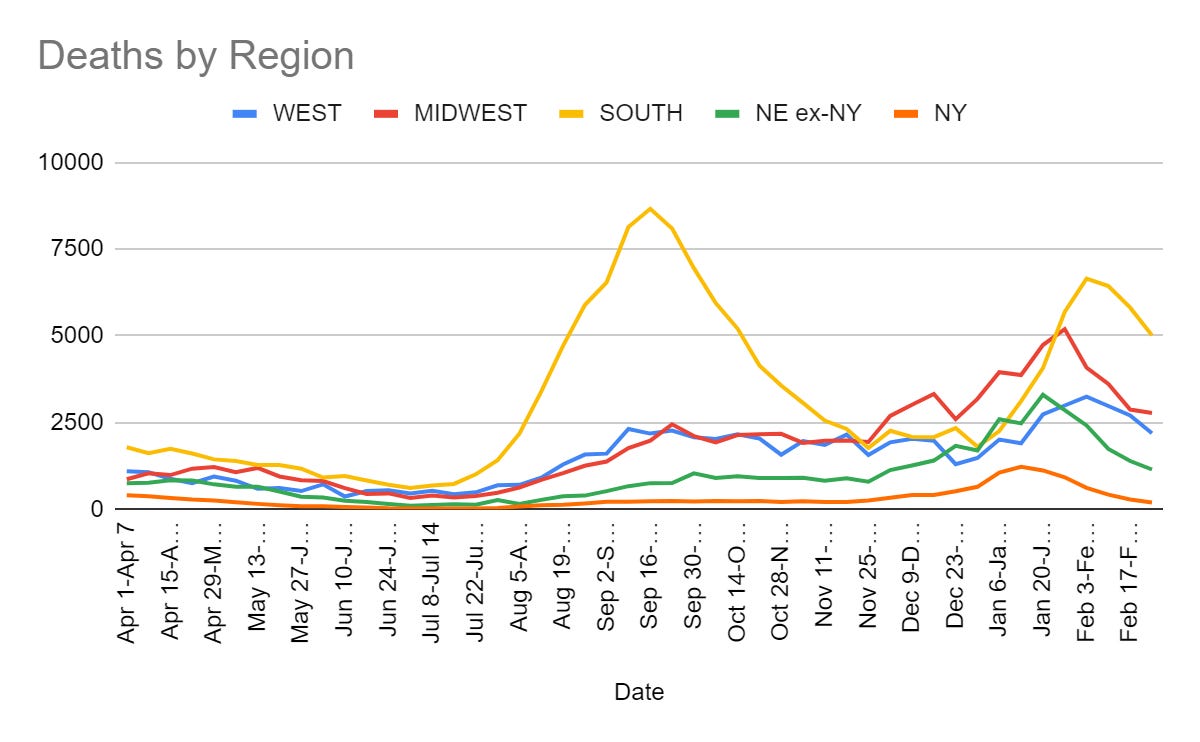

We have to conclude that for whatever reason it takes remarkably long for Covid cases to result in some of their resulting Covid deaths. This then raises the question of why death counts go up the way you would expect but then are going down slower than that. I don’t know. Maybe it has something to do with Omicron, which would be bad news. I am definitely continuing to think about what might be going on here.
Cases
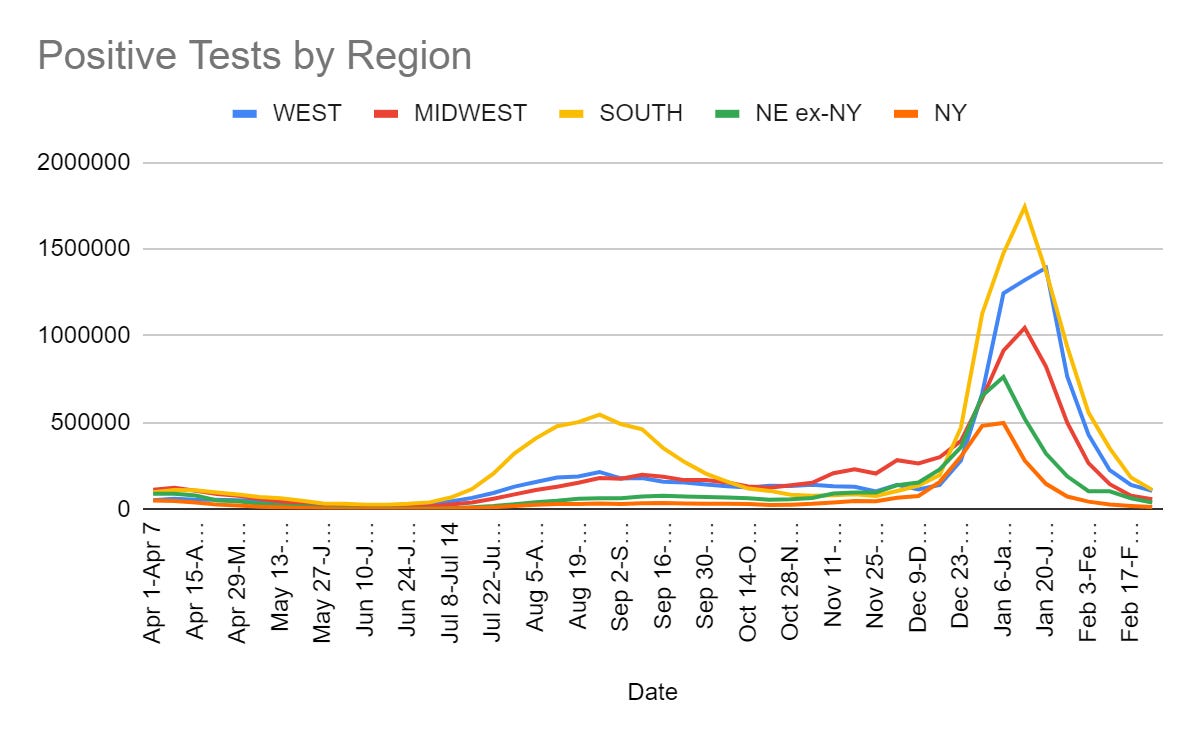

Chart is starting to become effectively impossible to read due to the previous peak. I’ll think about what to do about that.
World Modeling
Bob Wachter also concludes BA.2 is not worrisome beyond the potential for somewhat faster spread.
Tatiana Prowell surprises with an excellent thread acknowledging that her dire predictions of massive destruction were wrong and going into the physical reasons why. This is The Way. She looks into which of her assumptions were wrong and how those false assumptions led her to make the wrong conclusions. Some of her false assumptions are not called out explicitly, but they remain clear from the thread, which is still unusually great.
She first goes over the part she got right, that there would be a ton of Omicron cases.

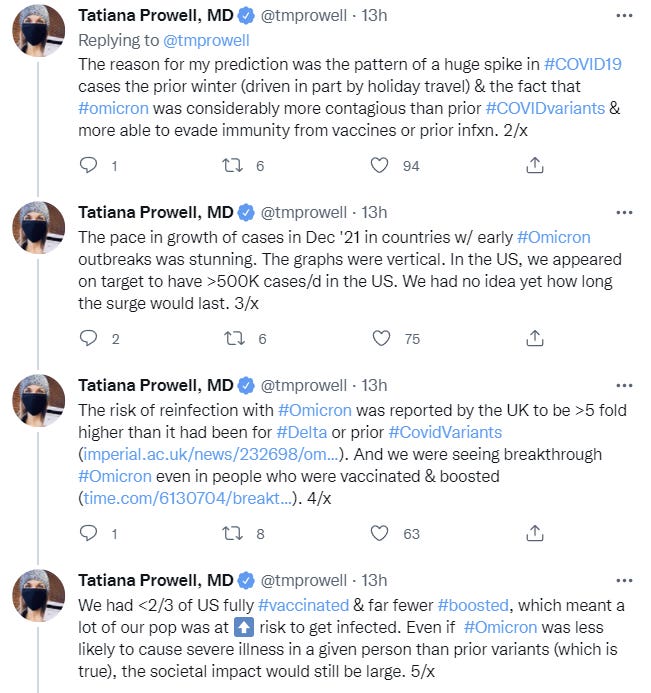
This part was indeed quite right. There were a ton of Omicron cases. Where her predictions were wrong was that she expected this to lead to massive disruptions. Those disruptions didn’t happen, so she asks the right question, which is why.


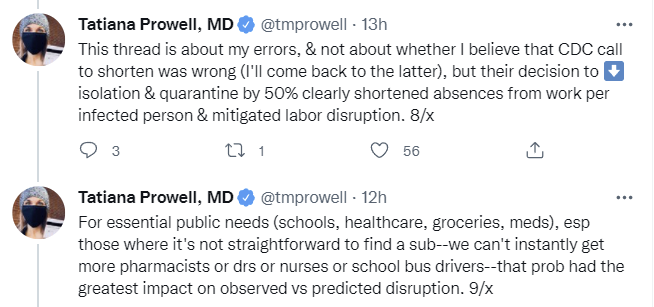
Tatiana’s model said that people would abide by the CDC guidelines and isolate for 10 days when infected, even if that meant massive disruptions, presumably because that’s what one does. Instead, not only did people do the practical thing and ignore guidelines when it was sufficiently vital, the CDC altered its guidelines to relieve a lot of the pressure.
What she doesn’t mention is the additional assumption that shortening isolation would make conditions much worse. I am confident this was previously part of her model, that people who came back after five days would make Omicron spread faster and ultimately therefore cause lots of additional disruption. That did not happen. If there is one flaw in the thread, it is that she sidesteps whether the CDC was right by ignoring the question of the magnitude of the downside, which ultimately proved quite small.
In turn, this should update us to be more confident that indeed a five day quarantine requirement is sufficient in practice. While such people are not fully safe, it is a question of magnitude.

Quite right, and an odd mistake to originally make. At the same time she was calling on people to alter their behavior and was altering hers, she did not expects others to change behavior, despite it having happened in previous waves. This seems like a pattern, where those calling out dire warnings and for strict requirements never expect private behavioral adjustments.

This feels mostly like grasping at straws. It’s true that regional disruptions were not all synchronized, but the amount of one region helping keep another region running smoothly seemed like it was minimal even for the hospitals, so this likely had minimal impact. If anything, it meant more disruption via some places having big trouble.

Indeed. The thing is that there was nothing to be done about the vast majority of those deaths. It is not that we ‘tolerated’ it so much as we endured and dealt with it. Causing massive disruptions, including in other medical care, would not have made the situation any better – we did triage, and for once we did a decent job of it.

Bingo. Big props for realizing it and calling it out. Thinking Omicron could cause massive disruptions was absolutely right. For a while, I was warning that such disruptions were possible and attempting to estimate how likely they were, slowly concluding they were unlikely. Thinking probabilistically under uncertainty, and realizing there is much we do not know, is necessary.
Seeing this thread gave me hope. The default thing to do is pivot and pretend mistakes were not made, or at least not look at them. This was the opposite, and done the right way. Kudos.
Free To Be You And Me Says CDC
The CDC says many Americans can take their masks off.
The CDC’s new guidelines are based on hospital capacity, and put a remarkably large amount of the country into the green zone.

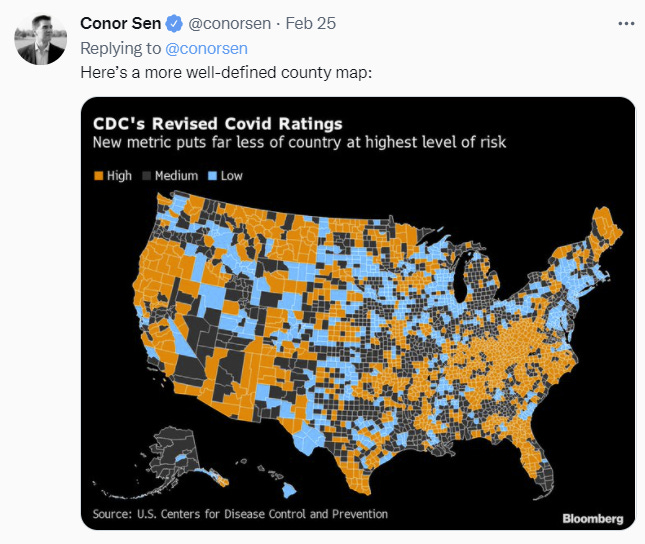
It was felt necessary to emphasize that they will make an exception, and in this case that which is not mandatory is not forbidden, and thus allowed.

I am as pleasantly surprised as you are. Banning mask wearing would have been quite the flex. I do expect there to be some places that ban masks, of course. I do wish they wouldn’t, but it’s their call.
These new guidelines don’t change the requirements that people wear masks on well-ventilated airplanes or near-empty buses and subways. The agency is still also recommending that people, including school children in K-12 schools, wear masks indoors in the 30 percent of counties where the risk of COVID-19 is ranked as high.
The in-school masking recommendation is being lifted for school children in low- and medium-risk counties, however. That’s a change from CDC Director Rochelle Walensky’s comments from just last week. The director had said in a closed congressional hearing that she had no plans to change the agency’s recommendation that all school children continue to wear masks, according to reporting from Reason‘s Robby Soave.
It would only be a contradiction if the CDC had a plan.
It also appears they have been systematically holding back their statistical data? I’d say what the hell, hero, except hey, it’s the CDC.
State of the Union
Biden gave the State of the Union address on Tuesday, which I watched so you didn’t have to. Mostly it was the usual grab bag of various applause lines that for whatever reason people think is the politically astute way to approach this situation, and had a part about Ukraine stapled onto the front end. None of it was especially insightful or new on any topic, other than Biden’s emphasis that people would be able to take a Covid test at a pharmacy and then get Paxlovid handed to them on the spot if it comes back positive. That’s pretty great.
The clear takeaway on Covid-19 was that Biden was ready to agree we could all move on, and that was a good thing. He plans to offer more free tests and continue to promote vaccinations and other neat stuff like that, but it was obvious his heart was no longer in it. He is dealing with a war that could potentially become World War 3, he’s dealing with inflation, he’s dealing with Manchin, he has a Supreme Court nominee and everyone is ready to move on from masks and mandates that are polling increasingly terribly.
So that’s that.
Biden then released a 96-page roadmap. I ran out of time before I could examine it in detail, but all early reports are that it is quite good. I will analyze when I can.
Prevention and Prevention Prevention Prevention
Biden’s polling firm recommends declaring victory and letting people leave home.
France drops lets my people go, drops vaccine pass.
New York lets my people go, including yours truly. Woo-hoo!




Almost. But not quite. The private employer vaccine mandate will remain in place. This is one of the least justified ones.
Yet the mayor said Monday that letting Kyrie play would “send the wrong message,” echoing his earlier claim that lifting the vax mandate might send “mixed messages.” Yet now it’s keeping this rule that mixes up the message.
Day to day it is also one of the least annoying, but it is still time for such things to go. When you don’t want to do something because it would ‘send the wrong message’ it is clear that you are imposing restrictions in order to send messages.
And of course private citizens and locations are free to continue being needlessly paranoid, so the mask will keep coming on and off every so often.
As usual, it can be enlightening to look at top comments to the vaccine mandate announcement:

It’s insane to think the mandates are doing this level of work especially going forward. The only way to think it is if you think the whole thing is a morality play.
The more Narrative version of this objection looks more like this.
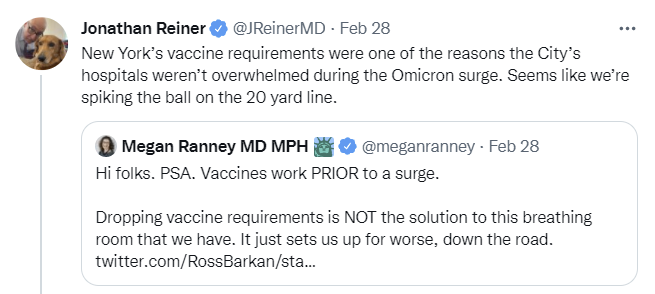
You have to love the logic there – the claim is we must keep requirements in place forever because of problems that will happen at some point in the future, so we have to keep punishing non-compliance now even though it has no other function and mostly annoys everyone.
I’m totally loving this new mayor, who ‘can’t wait’ to phase out the mandates even if he does end up waiting a little while, and is also calling out that it is time to return to the office.
“You can’t tell me you’re afraid of COVID on Monday and I see you in a nightclub on Sunday.”
The crack sparked laughter among the audience at the Sheraton New York Times Square Hotel.
Adams said that white-collar workers who continued working from home were hurting service-oriented businesses that rely on a steady stream of customers.
“That accountant that’s not in his office space is not going to the cleaners,” he said.
“It’s not going to the restaurant. It’s not allowing the cooks, the waiters, the dishwashers [to make a living].”
An important distinction to keep in mind is between benefits and costs. There being more suits to clean is a cost. All these services that people require are costs. If the reason people need to go to the office (which is a cost!) is to then use other services (which are also costs) then something is deeply wrong. There are real benefits to (many people) returning to their offices, and those are important. There are also real benefits to division of labor, and it’s good to have more people enjoy more nice things, which can include things like restaurants. But let’s remember what goes on which side of the ledger.
Getting back to the health-based concern trolling naysayers, we do need to Remember: The goal of many was and is Permanent Midnight, and the goal of other public health officials is to not waste a crisis in order to achieve orthogonal political goals.




Except no. I’m sorry, kid. If you’re a politician you’ll always be wearing a mask.
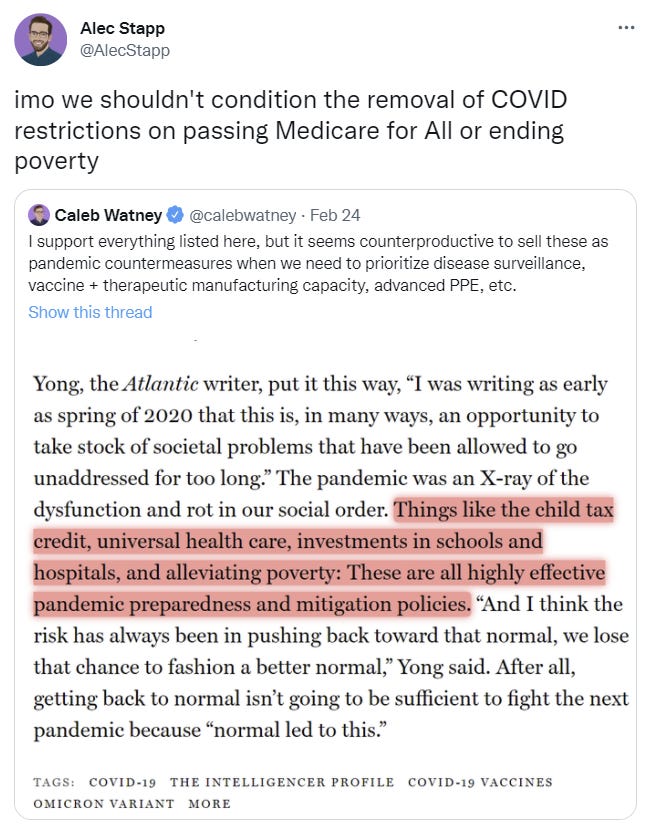

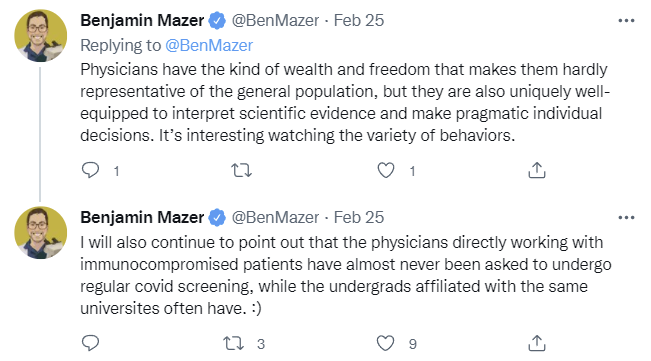


The changes desired may or may not be worth making, but that is based on whether they were a good idea before the pandemic. They’re either good ideas or they’re not. Holding the lifting of pandemic restrictions as a hostage to force through such measures is a whole different thing. The shift between the different claims, as ways to create a new normal that’s very different from the old normal, also needs to be noticed.
There has been a tension between ‘Covid will condition us to obey arbitrary and dehumanizing restrictions on our behaviors’ versus ‘Covid will teach us that our authorities will attempt arbitrary and dehumanizing restrictions on our behaviors and we need to learn to not allow this.’
Here’s a link to Barro’s full post.


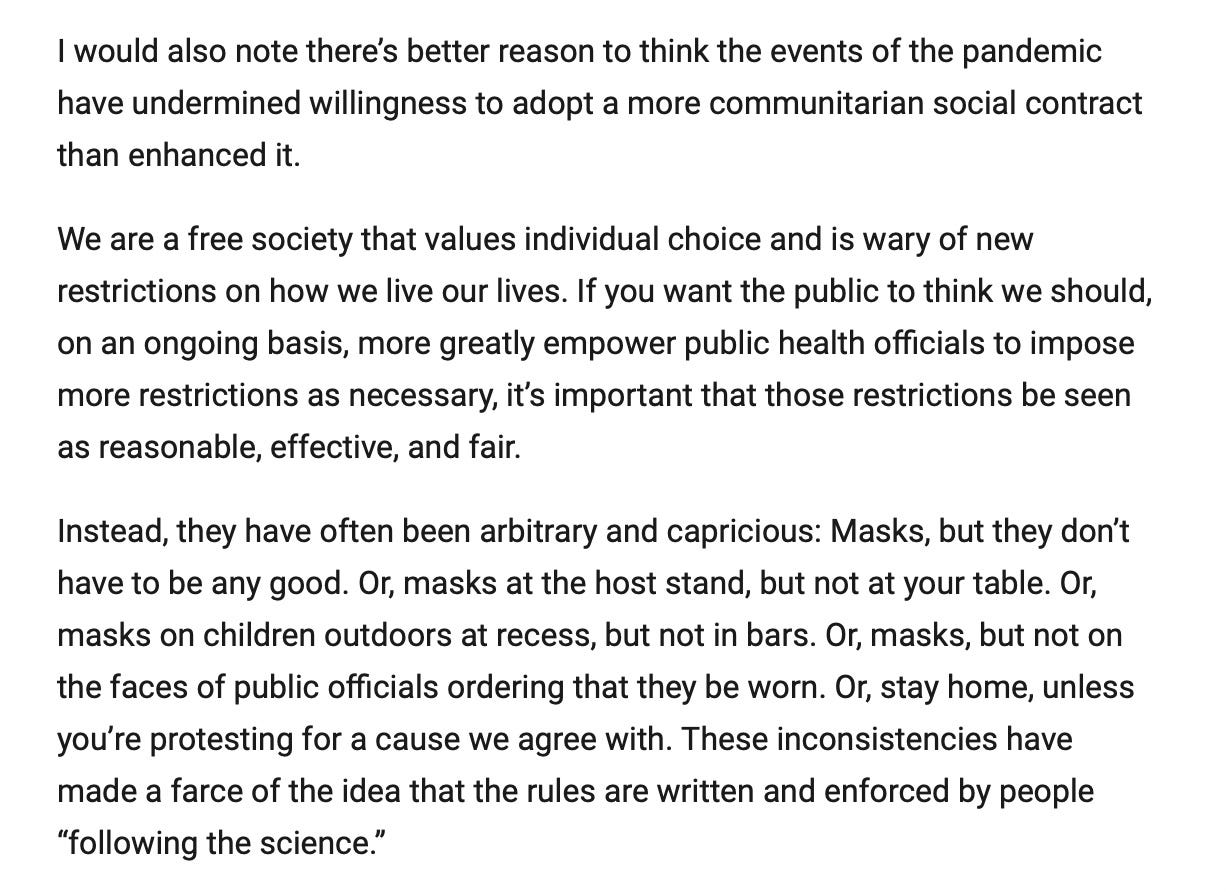
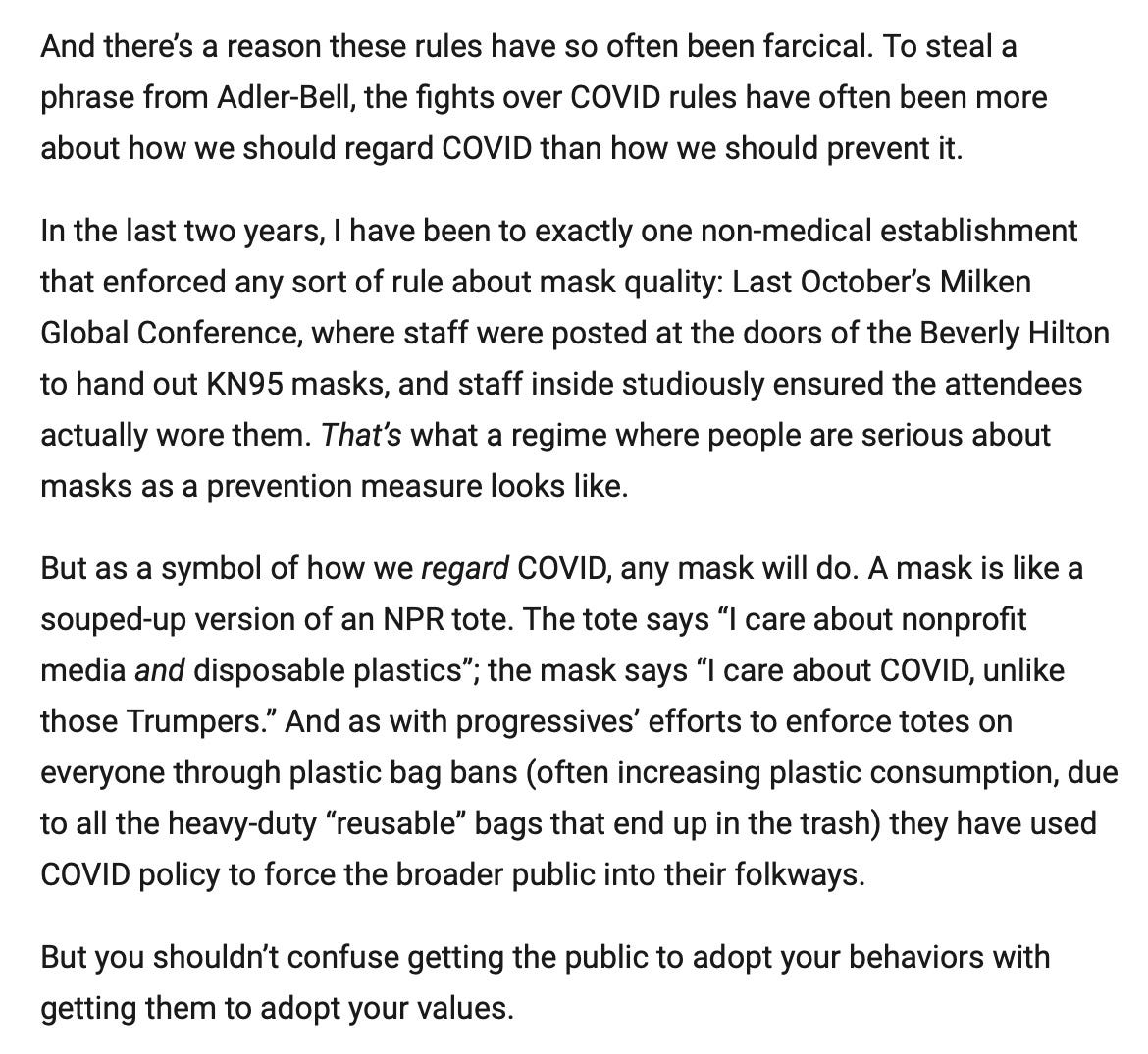
The Fear has been that the first effect would dominate, and we would end up with Permanent Midnight. The outcome remains unclear, but recent events seem to clearly point in the other direction, even if we’re starting to see counter-productive punishments and signaling surrounding Russia instead. Some things, like war, never change, even when they change a lot.
I continue to think this is exactly on point:

Think of the Children
A CDC estimate claims more than 58% of American children have had Covid-19. We mostly did not notice or care. They estimate 43% of adults have had it.
Covid Arithmetic for Anxious Parents, from Bryan Caplan. I could quibble but, as Bryan points out, no quibble is going to change the answer.
When the Narrative shifts to embrace the position one was previously holding, there are two choices.


Option one is to point out that the Narrative has been gaslighting us for years saying that asking children to wear masks was no big deal and laying groundwork such that we might never be able to ‘move forward’, and suddenly saying ‘it’s a lot to ask’ and that ‘at some point we have to try moving forward’ while pretending they hadn’t done so is highly hypocritical and infuriating, and to give no quarter.
Option two is to point out that they’re talking sense now and acting compatibly with life, and one could not reasonably ask for more than that.
I’m mostly in the second camp. The penalty for being late should not be death, so go and sin no more. And yet. Remember.
The flip side of this is that such lifting of mandates is often delayed for no reason. A week from now you won’t have to wear masks, but for now you must continue, despite thing being safe enough already to justify lifting the mandate. Or you’ll lift some mandates, but leave others in place for no physical reason.
For example, you might say it is for, and I quote, “continuity?”


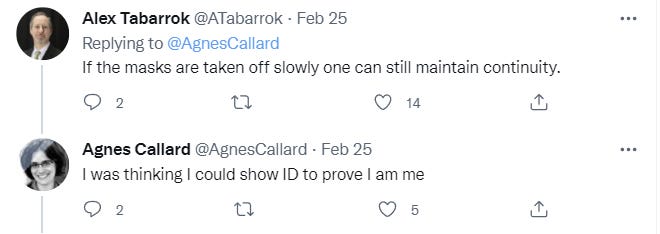
Perhaps students would notice the fundamental truth that none of us are the same as our past selves, and this particular philosophy class does not have time for that.
Knox County continues to have judges forcing all kids to mask, including those who need speech therapy, because of a lawsuit saying that it is required to ‘accommodate’ some students. This is despite almost everyone involved on all other levels not wanting this outcome, yet here we are.
In Other News
New preprint on origins of Covid-19, provides more data but does not seem to offer up much clarity.
SNL skit on what Covid discourse is like. Question the Narrative?
Yes, there are those who are so terrified of Covid that they would advise practicing social distancing in the wake of nuclear Armageddon. This is an insight into that type of thinking. I do think keeping your mask on would be wise, but for obvious other reasons.
Putin is having all his meetings over video conference or comically long tables. Ostensibly the reason is Covid. I am guessing there is a different reason. Could help explain him being out of touch in various ways.
Insight Prediction is an additional prediction market source. As far as I can tell volumes and liquidity remain quite low even on war questions and are essentially zero on Covid, but every little bit helps and I’m happy to link to everyone in this space.
Watch out, if you make a customer wear a mask they might arrange for a very real warrant for your arrest, signed by very real officials and everything, no really, and send it three times to make it clear how important it up.
Senator Tim Kaine introduces bill on Long Covid, claims to be suffering from it himself. He got Covid in spring of 2020, continuing the pattern of very early Covid cases leading to a hugely disproportionate share of claimed cases. His bill would mostly gather information, so likely it is good.
Not Covid or Ukraine
I’m adding ‘or Ukraine’ here. I am still figuring out how I am going to deal with the Ukraine situation, but posting small things here is definitely not The Way.
FDA approves a condom and the first thought is the correct one, that we should suddenly worry that we might lose access to condoms or have to pay huge markups. Luckily it does not look like this is the case.

Congrats on the new member of the family. I still remember the birth of my son, by far the most moving event in my life. I imagine you don’t get very jaded on repetition, either.
“This then raises the question of why death counts go up the way you would expect but then are going down slower than that.”
I think you must be modeling this wrong: Obviously, Covid can’t kill you any faster than instantly, but a long, lingering death is at least possible. So, rather than a symmetric bell curve, you would normally expect something that looks more like a thermal distribution, front loaded but with a long tail.
Covid messes with gas exchange in your lungs for a considerable period after you’ve gotten over the acute symptoms, and even mild hypoxia isn’t good for you, elevates your chance of death from all sorts of causes. So we’ve even got a plausible physical mechanism for that long tail.
“This then raises the question of why death counts go up the way you would expect but then are going down slower than that.”
I think you must be modeling this wrong: Obviously, Covid can’t kill you any faster than instantly, but a long, lingering death is at least possible. So, rather than a symmetric bell curve, you would normally expect something that looks more like a thermal distribution, front loaded but with a long tail.
Covid messes with gas exchange in your lungs for a considerable period after you’ve gotten over the acute symptoms, and even mild hypoxia isn’t good for you, elevates your chance of death from all sorts of causes. So we’ve even got a plausible physical mechanism for that long tail.
Not exactly WYSIWYG, is it? I don’t suppose you can fix that…
Repetition just means you’ve got more and more interesting permutations to discover.
My son and his (2.5 year younger) sister are best friends now, but it took a few years. He was much less happy about the situation than his big sister was, at first.
After my wife got pregnant, shortly before we learned the sex,
“Would you like to have a little brother, or a little sister?”
“No thank you to those.”
And then shortly after,
“You’re going to have a little sister!”
Utterly distraught: “I said no-thank-you to that!!”
Congratulations, Zvi!
He should have added a “Good day, sir!” to that.
Mazal Tov! I feel happy for you. May you enjoy much nachas from the newcomer and the rest of your family.
I heard an interesting theory of where America’s uniquely crazy “toddlers must wear masks” policy came from. In April 2020 the CDC’s website updated to state that children under the age of 2 should not wear masks, presumably because people were worried about a choking hazard or something. This is an entirely correct policy aimed at preventing excessive countermeasures. But leave those words up there for long enough and eventually some bureaucrat notices the corollary that the CDC is implying children over the age of 2 *should* wear masks, so it becomes policy because that’s how bureaucracy works.
In non-Covid news, I tried to get back into Magic: The Gathering and I now completely understand why Zvi quit. I booted up Arena for the first time in a year, netdecked something sweet and jumped into the queues. Naturally my rank had dropped to zero while I was away so Arena kept pairing my tier 1 deck with newbies on precons, and because Arena is designed to encourage grinding rather than competitive play a ten game winstreak wasn’t even enough to pull me out of bronze. Arena literally won’t let you play against real opponents until you burn many hours stomping kitchen table decks.
I couldn’t justify the time investment but if anyone’s still playing Standard I highly recommend Naya Runes, deck is messed up.
The “everyone except {children under 2, …} should wear masks” also got copied into the https://www.ready.gov/nuclear-explosion referenced. It also contains “If you are told by authorities to evacuate to a public shelter, try to bring items that can help protect yourself and your family from COVID-19, such as hand sanitizer that contains at least 60 percent alcohol, cleaning materials, and two masks per person.” This is *the entire* list of what they mention one should try to bring!
Congratulations to you and your newly enlarged family!
Mazel tov!
There is a lag between cases and deaths, of course. Causality time-ordering being what it is. And the reporting paperwork being what it also is.
When I last analyzed the Boston wastewater mRNA data at the beginning of February, I used the number of days delay between wastewater mRNA and cases or deaths as a hyperparameter. It was optimized to give the best p-value in a regression of cases/deaths on wastewater mRNA. The optima were 7 days delay from wastewater mRNA to case reports, and 19 days to death reports. That result is specific to the Omicron wave, as the waves in Boston have tended to be sui generis for a variety of sensible reasons.
So one should expect at least a 19 – 7 = 12 day lag between case rates and death rates, perhaps?
(That doesn’t explain why the rise is different from the fall, though.)
Log transform the vertical scale, maybe?
Y → log10(Y + 1)
This maps 0 to 0, keeps you out of log(0) jail, stretches the base while compressing the peak, and is easy to explain to anybody mathematically literate enough to understand the graph in the first place.
Ok, that one goes on my quotes page.
It’s completely excellent! Especially if the pharmacist gives very clear instructions on when and how to take the pills, since the last thing we want is for people to stop early and breed paxlovid-resistant variants.
Also excellent: unlike when I tried the search for paxlovid in the Boston area in mid-January, it now appears that paxlovid is widely available (53 Boston-area sites with availability > 0 as of this morning). It is, though, very hard to manufacture!
Bebtelovimab, the newly approved (and apparently only?!) antibody therapy effective against Omicron/BA.2, is in somewhat shorter supply (only Boston-area 6 sites as of this morning). That matters, and I mean that in a personal skin in the game kind of way! A close relative who is older, overweight, and has an implant requiring several drugs contracted COVID-19 despite being vaxed and boosted. Because of drug interactions, he was ineligible for paxlovid. (Though his doc couldn’t find it anyway, until nudged pretty hard.) So he had to get infused with sotrovimab, which at the time still worked against Omicron/BA.1 and was still available. And even then, I had to nudge the doc to use sotrovimab instead of one of the earlier ones that was ineffective against Omicron, and then they somehow lost the appointment, and… all the usual mishegoss. Fortunately, sotrovimab worked like a charm for him, once we got it in him.
If my relative were to get COVID again, we’d have to dig up bebtelovimab. Which is again, predictably, in short supply. To be fair: I know people involved in antibody manufacture. It’s ludicrously difficult at times, especially for a new ab under time pressure.
So… not a class in existentialism, then. :-)
Thank you for linking your quotes page, I liked a large fraction of it.
– Zvi’s blog is called Don’t Worry About The Vase.
– “Always side with the truth. It’s much bigger than you are.”
I’d like to suggest that this quote is terrible, particularly for the “rational&scientific” category.
– “[…] dehumanize people and turn them into numbers […]”
I apologize for ignoring the rest of the quote, but when-/wherever I encounter a phrase like this I always suspect that the speaker is the one who doesn’t _get_ numbers, and (unfortunately, mostly correctly) expects that the same flaw is very common in his audience.
Thanks; fixed in both places.
Hunh. I kind of like it: Nielsen-Hayden suggests struggling against the truth is a battle one will always lose, eventually.
Ah. I understand and respect your visceral reaction, since I get that a lot too.
But if you ever do read the rest of the quote, I think you’ll find that Bronowski actually agrees with you. Indeed, the very next words are “That is false: tragically false.” I liked his appeal to Cromwell’s plea for appreciation of uncertainty (with the full irony that Cromwell is not exactly to be emulated in all matters).
So I always parse this one as an appeal against hiding behind numbers to demonstrate excessive certainty. Heaven knows, I’ve dealt with enough datasets that pretended certainty via numeric tricks when reality called for no such thing. (And indeed, a colleague or two who insisted on erasing the error bars on analyses I did for them to increase the air of certainty to management. Rather than calling down a rain of fire for scientific ethics violation on them, my manager elected to have a short exciting conversation with their managers, and told me only to provide them only with password-protected documents in the future.)
Thanks for reading through; you might be the first one to have done so!
Bronowski may agree with me, but I don’t agree with him. I left the rest of the quote alone because I found it an unremarkable mess of parts I find good, bad and not evaluable by me (i.e. whatever religious message it has). It’s clear he’s trying to express that something has gone terribly wrong, is trying to wrap his mind around what/how/why it did, and hasn’t taken the usual easy outs for mental strain. That doesn’t mean he’s succeeded. How do science, reality-testing, knowledge/ignorance even enter the picture? There is a topic where these concepts go together with “arrogance” and I’d even throw in “hubris”, most centrally in engineering disasters, commerce, the military, and so on — people assuming that things will turn out the way they expect/wish, effectively because of their expectation/wishing. But on the topic of the Holocaust, what he said doesn’t make any sense, the concepts don’t apply — in terms of engineering, the intended result was achieved –, unless perhaps one were to assume that “moral knowledge” is the same kind as scientific knowledge, that it can/should be reality-tested in very similar ways, and thus Auschwitz is wholly analogous to a collapsed bridge.
The quote also includes “and that was not done by gas. It was done by arrogance/dogma/ignorance” which tries to do a potentially valid thing (“X and Y both contributed to Z, and I want you to put more explanation-weight on X and less on Y than you currently do” and/or “yes Y caused Z, but X caused Y, so you should consider X rather than Y to explain Z”) but why on Earth does he implement it like this, denying what physically happened?
> “Always side with the truth. It’s much bigger than you are.”
> Nielsen-Hayden suggests struggling against the truth is a battle one will always lose, eventually.
Well, that too… and that by itself would make a much better quote! What the original explicitly says is “side with”, and thank her/you very much, I don’t want the buttons activating alliance-processing to be pushed in a quote about rationality. It’s a rather more esoteric/paranoid/false-positive-prone judgment, but the “much bigger than you are” also strikes me as fishy. The minimum that I can say without sounding stupid/paranoid/gotcha is that it reinforces the frame where the interesting thing about Truth is that it’s a useful/formidable ally.
Typo: send it three times to make it clear how important it up.
There will always be people who makes their resistance to whatever they perceive to be Permanent Midnight the center of their political identity and they will pick up other contentious issues to be outraged about and distance themselves from. Those will dissolve into the Conservative/Anti-woke/Crypto/Sovereign Citizen crowd. Other than that, move on if your government have Let Their People Go. If your government makes Permanent Midnight their ideology (“Zero COVID”), then those will be warranted.
Gonna follow the nuclear and trade breakdown threat from now on, for our own good. Those are more catastrophic than COVID at this point.
Congratulations! I have 3 children as well and, while it’s hard, it’s so amazing. Wishing you and your family well!
Mazel Tov!
Congratulations!
tl;dr: At my workplace, it’s becoming clear that most health and safety protocols are in place just to give people peace-of-mind. They’re not doing much to lower actual risk.
—
I am involved with a committee to set health and safety protocols at work. For the record, I’m a lifelong lefty-liberal in an extremely lefty-liberal industry. We have had a vaccine mandate for months. We have a booster mandate starting in a few weeks. (Even before that, we were at >95% boosted. As of now I think there’s literally one person who hasn’t gotten a booster.)
We have done weekly or twice-weekly surveillance testing for over a year now. There have been 0 positives, either PCR or antigen. People have caught covid, but we have not had a single case of spread at work, or even between employees socializing outside of work. Ventilation was upgraded at the beginning of the pandemic. We are about as low of a risk workplace as possible even without masks and testing. My employer even provides KN95s.
We’re finally getting to the point where the consensus is to go masks optional, but some people don’t want this unless we INCREASE testing to 3x or more per week!
I have a mental list of messaging that has done more long-term harm than good. “My mask protects you; your mask protects me,” is on that list. If you are boosted, everyone around you is boosted, AND you are wearing a respirator mask, about the only way you could be substantially safer is to stay home. Your respirator does, in fact, protect you.
My preference would be to eliminate testing and admonish everyone to stay the f home if you are even the slightest bit sick, but the consensus is to keep testing. All testing is doing at this point is providing peace-of-mind. It’s a waste of time and resources. I’m happy to show courtesy to people around me to make them feel more comfortable, but that can only go so far. Unfortunately my responsibility is to represent the interests of my colleagues, so the best I can do is gently nudge them.
—
Re: This tweet in the Tatiana Prowell thread:
> The fourth reason I believe my prediction was off was that the #omicron wave peaked & fell very rapidly. This pattern had been observed in S. Africa, but we were unsure if it would be replicated here or elsewhere. It was. This was a gift. We’re lucky. 14/x
In Jan, before the full force of Omicron hit the US, I got into a debate with a covid data modeler about this. I said that we should probably assume Omicron will act like it did in S Africa. I was admonished: told I didn’t understand how to think scientifically and did not have the training to intelligently participate in the discourse. While it’s technically (and trivially) correct that Omicron may not behave the same way in two different places, it’s not a good way to inform policy. I don’t know where this thinking comes from, that we should assume we know nothing rather than using prior experience to inform our assumptions. It’s the same line of thought that brought us gems like “covid is not airborne.”
“I don’t know where this thinking comes from, that we should assume we know nothing rather than using prior experience to inform our assumptions.”
I continue to make accurate predictions with my theory that most people, even most Serious People, start from a desired response and work backwards to find a model that justifies it.
My model on that last point is that there are people who think that The Scientific Method is some combination of:
1. Form a hypothesis and then test it in a published journal with p<0.05.
2. What authorities tell you.
And nothing else counts at all, not when Doing Science, either (A) unless it serves the Narrative in which case you can use any kind of Calvinball logic or (B) actually no matter what.
And yes, the protocols were always about peace of mind or shielding from liability or other similar things.
I am fairly confident this person, like many scientists and academics, falls into the Ed Yong category of hoping the pandemic would remake the world in his image. Their game is to dig into any paper that contradicts their desired narrative to find flaws, keep their mouths shut about flaws in research that supports the narrative, and gatekeep anyone who doesn’t have their level of credentials. (“if you haven’t been trained in how to read a scientific paper, you can’t intelligently participate in the discourse.” “stay in your lane.” “you can’t just read the abstract.” etc. etc.)
I’ve been correct on more predictions just by observation. I’m new to rationalism, so maybe a better way of saying that is that my model is more accurate, a big part of it being “assume things will behave as they have in the past unless given reason to believe otherwise.”
The hamster thing turned into a big argument. “I would sacrifice a million pets to save one human!” My response to that was “Hong Kong is going to get slammed by Omicron either way” (in coarser language…) Except for a few extreme measures like state-enforced lockdowns, NPIs can only chip away at the margins. Fine when that will have an actual, tangible benefit (like easing strain on the healthcare system or buying time to develop a vaccine). Extremely evil when those NPIs do actual harm (plenty of examples here).
And none of these people respond when asked, “what is the value of a human life?” because if they admit the value of a human life is finite, they lose their trump card, which is accusing you of wanting people to die.
> And none of these people respond when asked, “what is the value of a human life?” because if they admit the value of a human life is finite, they lose their trump card, which is accusing you of wanting people to die.
Were the case this simple!
Let’s begin with the conversational side. If whatever philosophy you do spits out in the end that human lives’ values can be meaningfully compared to each other, [and/because] they are not all exactly the same value (or somehow strictly incomparable), then usually people will get viscerally offended, and the conversation quickly devolves into someone (i.e. you) getting unfavorably compared to Hitler. It is entirely understandable that people give this conclusion a wide berth even if they believe it.
Philosophy side. Taboos and infinities are obvious signs that something went wrong. However, as a toy model (i.e. don’t take this too seriously), I would still recommend a humans vs. everything else divide, where “everything else” has no value by itself, but only because some humans enjoy/cherish them — in other words, because and to the extent their existence increases the value of human lives. While this mostly converts everything into a single unit, this still doesn’t quite let you compare killing pets to killing Granny, because Granny can enjoy things while pets can’t, but at least it gives you more interesting ways to shoot yourself in the foot if you take it too seriously. E.g. you could notice that humans also cherish other humans, try to accommodate this — and at the same time get rid of the assumption of all humans having the same inherent value and everything else having the same different inherent value of 0, which is ugly — by putting the whole thing into a huge matrix and finding its largest-value eigenvector. This has all kinds of neat properties, at the cost of also producing absurdities, a clear sign that you took this too seriously. Play with the assumptions a bit, as food for thought.
If you are trying to do a meaningful cost-benefit analysis of pandemic mitigations, you must acknowledge that human life has finite value. That’s the starting point. If you can’t even do that, there’s no way to have an earnest discussion about it.
Ironically some of the same people I’ve debated on this issue have said (pre-pandemic) that the US healthcare system spends too much effort and too many resources extending the lives of the elderly.
And philosophically I believe that to some extent the value of a human life is the value of its experiences, so (relating back to covid) restricting peoples’ experiences reduces the value of their life.
“Granny can enjoy things while pets can’t”
Or granny can communicate her enjoyment of things to us in a way we understand, while pets cannot.
> If you are trying to do a meaningful cost-benefit analysis of pandemic mitigations, you must acknowledge that human life has finite value.
> to some extent the value of a human life is the value of its experiences
Exactly. This is why I make in the toy model the explicit distinction that the only kind of value the model admits is enjoyment-by-humans, to hammer home that only its various types can be traded off against each other. (Er, assuming we were already at the Pareto frontier of lifespan vs. life-fulfillingness-per-time, which we mostly aren’t.)
> Or granny can communicate her enjoyment of things to us in a way we understand, while pets cannot.
Feel free to change that assumption, too. The model isn’t “this is how I think morality works” but somewhat literally a toy (a game-tool), like a construction set, to be put together in different ways and see what happens, because doing this can build intuitions. E.g. if you also allow nonhuman things to enjoy stuff, then you tend to conclude that, collectively, something random has more moral weight than humanity. (See such examples in https://slatestarcodex.com/2017/08/16/fear-and-loathing-at-effective-altruism-global-2017/ Separately, VHEMT exists.) Even without that, the model still has its utility monsters: famous mostly-cherished people. (I deliberately choose this description over “makes the lives of lots of people better by material impacts”, to make it clear this is a flaw in the model.) Less usually, this model also has the negative of utility monsters: if you find a famous mostly-loathed person (i.e. someone with negative moral value), then making them sad by e.g. killing their pets (but not changing the negative effect they have on other people’s lives) is _good_ according to the toy model. The fact that AFAIK a majority of people think this way, but I’m treating this as an obvious example of the model being wrong, should also reinforce that I think any model deriving morality from public opinion is either a toy or a mistake, depending on whether it’s taken lightly or seriously.
Just wanna say how much I love the “Calvinball logic” phrase, captures so many things perfectly
Congratulations! I am a third — and therefore superior — child and can attest that my parents worked out all the parenting bugs on my brother and sister.
On the difficulty of reading the case chart – is it reasonable now to cut the y-axis at 50,000? We’re over a month now since any region was at that level, and anyone who actually wants to see the Omicron weeks can access your history to view it (or you can even have a link to the updated and zoomed out version for anyone who feels like seeing that).
There are a lot of nice things about a log chart, but if you were going to do that, it would have made sense to do so a year and a half ago.
Even if a log chart would have been correct a year ago, that doesn’t make it wrong now! If I can easily figure out how to do that it seems better.
While you’re at it think you can normalize the graphs for population of regions? Display rates, not total numbers? You can’t really compare regions if they’re not normalized for population.
Speaking of poor threat modeling for existential threats. From here https://www.ready.gov/nuclear-explosion
“Try to maintain a distance of at least six feet between yourself and people who are not part of your household. If possible, wear a mask if you’re sheltering with people who are not a part of your household.”
I found out HK had around as many cases (~55k) and deaths (~200) as France and Turkey. Not Letting Our People Go might make some sense, but I expect we’ve reached the peak and will see a decline into April/May. Sad thing, no gradual lifting of restrictions until going back to literally zero, and stabilizing at a low level doesn’t count.
Yep. This too shall pass, but they are going through the same thing we just went through except more concentrated and therefore worse. But it should reverse itself soon.
OT, what did Justin Murphy just smoke?
70% narratives for forthcoming essays that has to do with DAOs eating the world and violating causality (what), 29% tinfoil-wearing, 1% a real prophet.
Sorry, I’m not allowed to talk about this. Fnord.
You have some very strange priors if you think there’s a 1% chance that Twitter posts about blockchain violating causality are prophetic.
Congrats!
Hey, continuity is important when 10% of high school grads lack basic object permanence.
https://www.theonion.com/ten-percent-of-u-s-high-school-students-graduating-wit-1819595387
Seriously though, I do think there’s value in large institutions giving lots of notice about policy changes, since it gives people time to plan and respond. Or, as Borges put it,
“The execution was set for the 29th of March, at nine in the morning. That delay was caused by the administrative desire to work impersonally and deliberately, as vegetables do, or planets.”
I was starting to get pretty paxlivid at the lack of information on when our best covid treatment is going to be available, and at the fact that nobody seemed to know or care to find out. Biden’s tweet referenced above actually just says “antivirals” and this is in line with what a doctor friend I spoke to told me – they’re prescribing Mulnupiravir, not Paxlovid.
Weekend Editor above pointed out there is availability at some Boston pharmacies, but in NY the only dataset I can find still looks like there are exactly 6 pharmacies which have ever been supplied in the city, and none of them have had a delivery since Feb 3rd. Does that mean they’re out? I don’t know. More important, though, is that pharmacists here didn’t get the memo the last time the CDC updated guidelines and were turning immunocompromised patients away from their recommended boosters, so I’m very skeptical anyone in the NY metro area can get paxlovid right now without extreme effort and luck.
(Emphasis added.) Hey, first things first: you should be awarded extra special superfine bonus points for the neologism “paxlivid”. It combines a Latin root for “peace” with an English word for “anger”, so it’s a perfectly mixed metaphor (linguistically & semantically) for describing frustration at a chaotic situation. I really like it!
Second, if you follow the instructions here on my blog, you’ll see that I was using a US-national database: the COVID-19 Public Therapeutic Locator, from healthdata.gov.
NB: As I cautioned in footnote 4, the mobile version of the COVID-19 Locator seems not to offer any filtering. But the desktop version works fine for me, at least.
I just showed the result when you restrict attention to Massachusetts and the Boston-adjacent counties, and ask for paxlovid with number of courses available ≥ 0. You can, of course, do the same for wherever you are in New York. (Or you could email me and I’ll even do it for you, with a set of instructions so you can repeat it on your own. I mean, if you need paxlovid, you should be able to find out where it is, and I’m happy to help out a couple people with that.)
Whether the relevant pharmacists “get the memo” is beyond my scope to solve, beyond suggesting printing out the CDC guidelines to take along and wave around at them. Not much hope that will work, but it’s all I got. I was never much on social engineering.
The Boston results were mostly big hospital pharmacies, where the pharmacists are pretty likely to be on the ball.
Zvi, any thoughts about this paper?
https://onlinelibrary.wiley.com/doi/10.1111/eci.13759
Just gonna be honest and say no. No new thoughts.
Zvi, does this study justify adding ivermectin to the paxlovid-fluvoxamine combo, or using the fluvoxamine-ivermectin combo in case paxlovid is out of reach at the early stages of infection? I was strongly against remdesivir and agnostic about ivermectin, but now I wonder if and how I should update.
https://www.sciencedirect.com/science/article/pii/S120197122100988
Correct link:
https://www.sciencedirect.com/science/article/pii/S1201971221009887
I consider the Ivermectin matter settled as not a good idea regardless, and this doesn’t look like enough for me to reopen the case.
Short answer: No, probably not.
Longer answer: I did a blog post taking the publication apart, looking at both plus and minus features.
Summary: